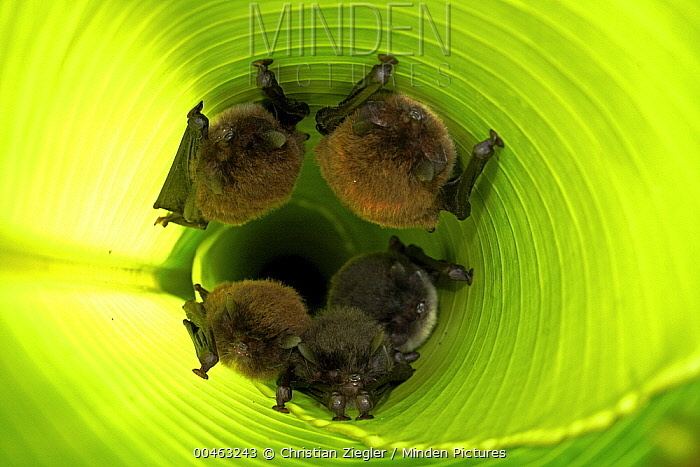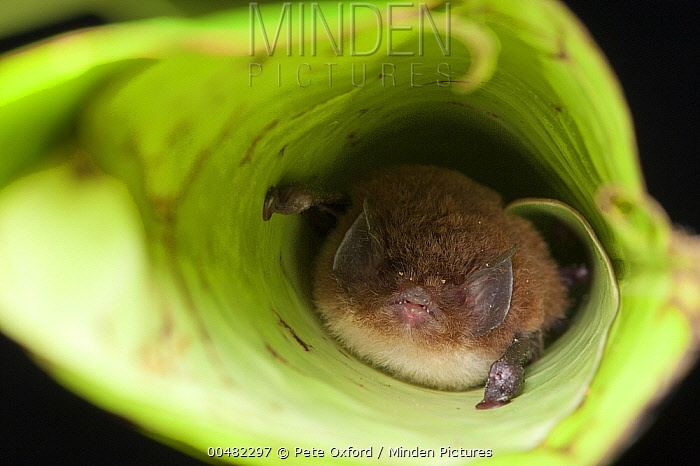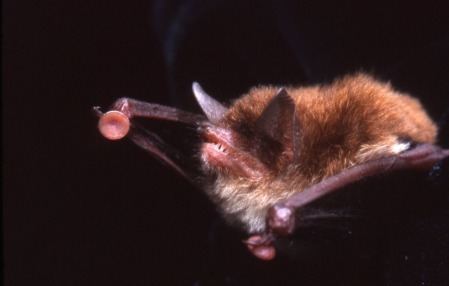Family Thyropteridae Scientific name Thyroptera tricolor Rank Species | Genus Thyroptera Phylum Chordata Order Bat | |
 | ||
Similar Thyropteridae, Bat, Greater sac‑winged bat, Hairy big‑eyed bat, Lesser sac‑winged bat | ||
Searching the spix s disk winged bat nicaragua
Spix’s disk-winged bat (Thyroptera tricolor), is an insectivorous species of bat in the family Thyropteridae. Although this species is unevenly dispersed, it is widespread and is therefore considered as having a “least concern” status on the conservation list. The most prominent anatomical feature of this bat, separating it from other bats, is the presence of disks on its thumbs and hind feet. These circular disks act as suction cups, allowing the bats to cling onto and move along smooth surfaces.
Contents
- Searching the spix s disk winged bat nicaragua
- Distribution and habitat
- Anatomy behavior and diet
- Disks
- References

Distribution and habitat
T. tricolor can be found in South America, in the Neotropical region and is native to the countries of Venezuela, Tobago, Trinidad, Suriname, Peru, Panama, Mexico, Guyana, Guatemala, Honduras, French Guiana, Costa Rica, Ecuador, Colombia, Brazil, Belize, and Bolivia.

Species abundance of the bat in its native Neotropical land may be limited by the availability of roosting sites. Whereas other species of bats are capable of aggregating in large numbers, hanging head-down by their toes from cave ceilings and hollow trees, T. tricolor is adapted to roosting in, and therefore limited by the abundance, or lack thereof, of furled leaves in its habitat
Anatomy, behavior and diet

Spix’s disk-winged bat possesses a white, or pale yellow underbelly and a reddish brown to black dorsal surface. The bats possessed an average forearm length of 36.8 mm and 35.57 mm for females and males, respectively. The average weight of this species of bat is approximately 4.02 grams, and their colonies maintain a sex ratio of 1:1. When studied, these bats did in fact display social organization, as well as roosting aggregation, with the mean colony size consisting of six members. Regardless of the bat’s specialized morphology, it is still able to maneuver in flight, with agility, as it circles the mouth of furled leaves which could potentially serve as a roosting location. T. tricolor has not been observed to fly at heights greater than 3 to 5 meters above the forest floor. As previously mentioned, the bat’s diet consists of insects, and estimates indicate that a given individual may consume up to 0.8 grams of insects a night.
Disks

Unlike most bats, T. tricolor clings head-up from its roost. This phenomenon is observed in six bat species which occur among two families, Thyroptera spp. and Myzopoda spp. The former are known as disk-winged, whereas the latter as sucker-footed. Although the two families represent an occurrence of parallel evolution, the manner in which their unique adhesive anatomy is utilized differs morphologically.

These bats cling head-up to the smooth inner, ventral surfaces of the rolled up leaves with openings at the top, of Heliconia, sometimes Calathea, as well as other similar plants, using their adhesive disks. This manner of roosting is said to facilitate rapid escape in the event of a potential disturbance. The bat’s disks take the shape of concave cups, and are supported by an internal cartilaginous plate. An extrinsic muscle, the flexor pollicis brevis, attaches to the plate, such that contraction of the muscle alters overall disc shape, creating suction. In order to maintain the integrity of the disk, T. tricolor is observed to groom the disk, by frequently licking it. In addition to that, the disk contains sweat glands which discharge onto its peripheries, thereby maintaining it in a constantly moist condition.
Contrary to M. aurita, T. tricolor uses the insertion of the flexor pollicis brevis to alter disk shape and adhere to a smooth surface, rather than detach from it. In addition to that, the bat uses suction, rather than wet adhesion (via sweat-lubricated disks) as the major mechanism for clinging. When unable to create a seal for suction, wet adhesion is in fact used, but only produces a very weak adhesion. Furthermore, in contrast to the sucker-footed bat, Spix’s disk-winged bat only roosts head-up, but can cling to a smooth surface at any angle, whereas the former can only attach head-up. As such, it is of note that M. aurita can concurrently make contact with both its adhesive organ and thumb claw, whereas T. tricolor cannot. This may be due to the difference in morphological features between the bats due to the varied muscular insertions and the different functions they bring about.
